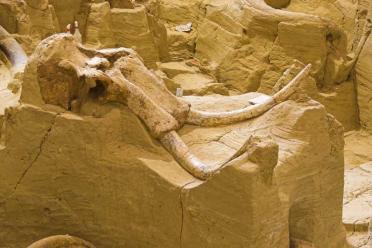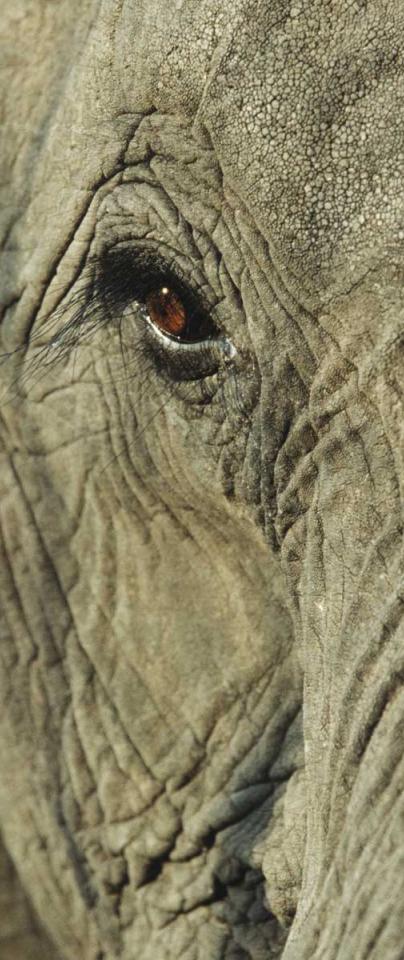The ins and outs of elephant evolution
Elephants once roamed the earth, and genomics research has now revealed the fascinating evolutionary story of elephants both living and long extinct.
Modern day elephants are now only found in pockets of African savannah, in the tropical forests of West and Central Africa, or scattered around South-East Asia. But elephants once roamed the earth, from the mighty mammoths of North America to the straight-tusked elephants of Europe. Now, genomics has revealed how the ancestors of these living and extinct populations intertwined and interbred, while some remained isolated deep in the jungle.
Great herds of mastodons once roamed the forests of North and Central America, crossing paths with the Columbian mammoths of the south and wooly mammoths from the north. Straight-tusked elephants once roamed the same lands as the Asian elephants that now inhabit South East Asia, from Europe all the way to India. Forest elephants have hidden amongst the jungles of West Africa for hundreds of thousands of years while their larger counterparts straddled the sun soaked savannah.
But how are all these species related to one another, and what sort of events drove the evolution of elephants around the globe? Genome sequencing of elephants long extinct and those still walking the earth, along with the use of powerful computing techniques, tells a story of speciation, migration and repeated hybridisation.
It wasn’t long ago that tracing the evolutionary history of animals was left to the fossil experts to sort out, something which the study of phylogenetics (the relatedness of bits of DNA), is helping us to piece together.
However, it’s one thing comparing the evolutionary history of living animals. Trying to piece together the whole story from fossils is another thing entirely, especially when they’re not usually as laden with abundant genetic information as their living relatives.
DNA is not a particularly stable molecule when subjected to the weathering effects of time, therefore ancient samples tend to be less-than-complete, and even that DNA is of ‘low quality’. However, getting DNA from ancient samples, including teeth and bones, is something that some scientists specialise in.
There are also some types of DNA that are, historically, easier to work with, such as mitochondrial DNA, which exists in multiple copies in each and every cell, and even in each and every mitochondria (the cell factories driving respiration). There are perhaps up to 10 000 copies of the mitochondrial genome in every human cell, for example.
These copies of DNA are relatively small, compared to a chromosome, and due to their sheer abundance it becomes a much simpler task to reconstruct a whole mitochondrial genome - even from ancient material.
Another useful facet of mitochondrial DNA is that it has a relatively high mutation rate compared to other bits of DNA, therefore it is pretty useful when trying to separate the relationship between different species based on their genetic similarity.
Using mitochondrial DNA, a team in 2005 was able to piece together the fascinating finding that, based on sequence similarity and rates of mutation of DNA, wooly mammoths and Indian elephants are actually much more similar to each other than African elephants are to Indian elephants.
The differences are, clearly, deeper than interestingly shaped ears.
Although it’s difficult to know exactly how a gene sequence of an ancient organism might look like (even knowing what the genome sequence of a living organisms looks like is not an exact science), at least with a decent living reference we can attempt to piece together the gaps.
What’s more, with modern computing methods, working out how best to fill those gaps is becoming a much simpler task - and ancient DNA has been used to piece together ancient genomes from Neanderthals to sabre toothed tigers, as well as mammoths and mastodons.

Ancient DNA is not as easy to come by as that of an elephant (for now). Researchers are forced to rely on fragments of bone, teeth, or preserved carcasses trapped long ago in permafrost. For this study, researchers extracted mammoth DNA from bone, molar teeth, tusk and fat tissue. Mastodon DNA was extracted from various different teeth, while straight-tusked-elephant DNA was taken from a petrous bone in the skull. The researchers point out that DNA from samples taken from more Northern latitudes, where specimens are found in permafrost, have much better preserved DNA and therefore have much more available for sequencing. However, even the straight-tusked elephant at 120 000 years old showed relatively good DNA preservation deep in the petrous bone, which seems to preserve DNA better than other parts such as teeth.
As useful as mitochondrial DNA has been in prizing apart the evolutionary history of elephants (and even humans), it doesn’t quite tell the whole picture, especially as mitochondria are only inherited via the maternal line.
Mitochondria from the father’s sperm cell tend to be kicked out of a developing embryo early on, therefore by looking only at mitochondrial DNA we don’t see the effects of recombination - and what goes on between sperm and egg tells much more of the story when it comes to evolution.
In 2005 a team including EI’s former Director of Science, Professor Federica Di Palma, released a full reference genome sequence for the African savannah elephant using classic Sanger sequencing. Now, a research study published in PNAS, of which Eleftheria Palkopoulou of Harvard Medical School was the lead author, has added hugely to the repertoire.
Using modern next generation sequencing (NGS) tools and high performance computing, the team managed to provide high quality genome sequences for two more African savannah elephants, two forest elephants and two Asian elephants. Not only that, they managed to provide a high quality genome sequence for a 120 000 year old straight-tusked elephant - a long since extinct species.
To add further variety, the team also managed to piece together the genomes of four wooly mammoths, a Columbian mammoth and two American mastodons, to a lesser extent.
Importantly, until now only a mitochondrial genome was available for the American mastodon. This piece of research has pieced together the nuclear genome of the mastodon for the first time.
Armed with this information, the research team could look at introgression - the gene flow between species as a result of hybridisation events - to really begin to pick apart the evolutionary relationships between these iconic animals.


We were astonished by the finding of multiple interbreeding events among different elephant species, involving ancestors of both living and extinct members of the family. Dr Eleftheria Palkopoulou, Harvard Medicine School.

Credit: sirtravelalot/Shutterstock.com
The story is fascinating, and shows how evolution isn’t just about speciation and mutation, but that gene flow between species carries on long after distinct populations have diverged.
In the words of lead author, Dr Eleftheria Palkopoulou, "We were astonished by the finding of multiple interbreeding events among different elephant species, involving ancestors of both living and extinct members of the family.”
The recent study really has transformed the way that we look at elephant evolution, which previously was modelled via simple ‘family trees’ in which different species branched off from a common ancestor.
However, the reality is that many of the ancestors of these species mated with each other, leading to a patchwork genetic legacy of which interspecies hybridisation played a huge role.
As an example, most of the extinct straight-tusked elephant shares ancestry with African elephants, but a significant portion of its remaining ancestry is related mainly to the African forest elephant and even the mammoths - a group far removed from the African elephants on the phylogenetic tree and more closely related to Asian elephants.
Essentially, though certain populations ‘branched off’ on the tree of life, other ancestral populations went through interbreeding events (known as ‘admixture’), which gave rise to species such as the straight-tusked elephant.
Although the team cannot precisely say at which point the interbreeding admixture happened, they can paint a possible scenario of how these events might have occurred.
The fossil evidence also adds to the exotic elephant evolutionary tale, which points towards morphological similarities between straight-tusked elephants and Asian elephants. It’s possible that, in the annals of time, a population that split off from the mammoths closer to the time when mammoths and Asian elephants went their separate ways added to an ancient hybridisation event.
Eleftheria adds: “Our findings demonstrate the potential for admixture between species that diverged millions of years ago and suggest that gene flow has been important in shaping the evolution and radiation of many different species."
In the case of the mammoths, it looks like the gene flow went primarily from one species to another, in this case from the Columbian mammoths of the south, which tended to stick to more temperate climates, to the American woolly mammoths of the north. This is reflected in the mammoth DNA samples, with more southern woolly mammoths having a higher proportion of Columbian ancestry.
Gene flow occurs in such a way in a variety of species, as is famously the case with ancient populations of humans and Neanderthals (and even Denisovans), which interacted and mated with each other as far back as 60-100 000 years ago.
Although this is a story of gene flow, it’s interesting to note that this stream can be plugged, even despite a long history of repeated hybridisation - especially in the case of the African elephants.
Adding to previous genomic research data, this recent work has shown that the forest elephants and the savannah elephants show 500 000 years’ worth of genetic isolation, with one species clearly preferring to stick to the shadows of the tropical West and Central African jungle while the other roams the sun soaked plains.
Though repeated hybridisation events that occur in regions where the two populations of elephants cross over (perhaps the result of how their respective ranges have been narrowed by human-enforced borders), this is not reflected in the representative genomes of the African elephants, highlighting their status as distinct species.
Federica di Palma, explained how this work is important when it comes to viewing evolutionary processes as a whole: “ As we continue to decode the genomes of many species, including extinct species, we are learning how gene flow and hybridization are key evolutionary forces in evolutionary diversification rather than destructive ones as per Ernst Mayr's theory.”